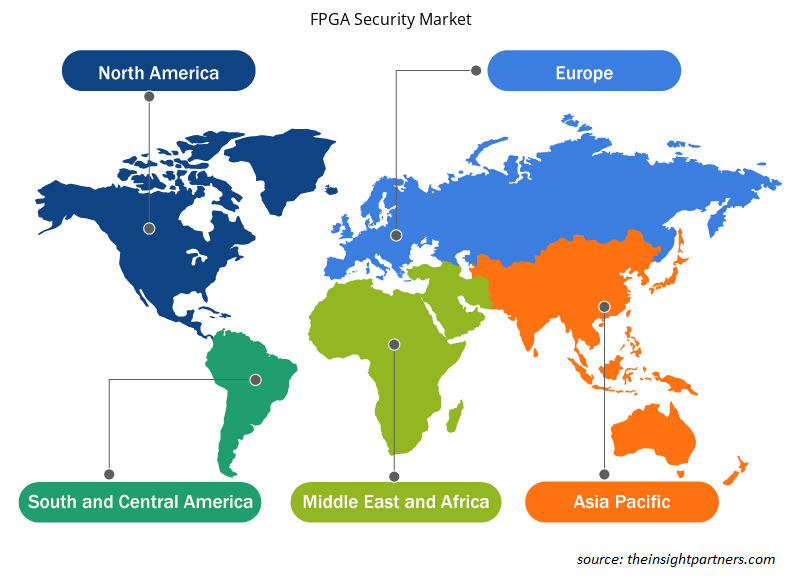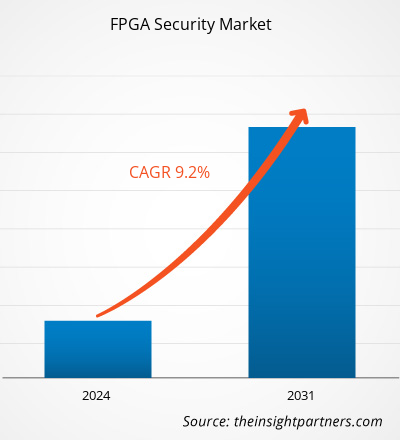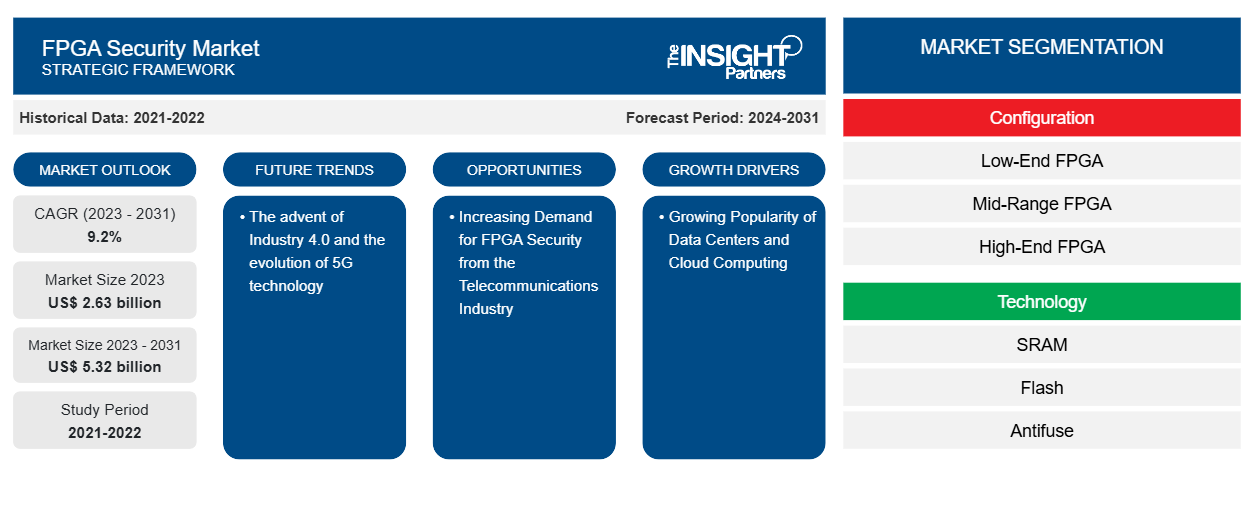FPGA 安全市场规模预计将从 2023 年的 26.3 亿美元增至 2031 年的 53.2 亿美元。预计 2023-2031 年市场复合年增长率将达到 9.2%。工业 4.0 的出现和 5G 技术的发展很可能仍是 FPGA 安全市场的关键趋势。
FPGA 安全市场分析
由于数据中心和云计算的日益普及以及 FPGA 安全技术与高级驾驶辅助系统的集成,FPGA 安全市场正在快速增长。由于联网汽车、智能建筑、电网和城市基础设施对 FPGA 安全的需求不断增长,市场正在稳步扩张。此外,电信行业对 FPGA 安全的需求不断增长,为市场增长提供了丰厚的机会。
FPGA 安全市场概览
现场可编程门阵列 (FPGA) 安全是一种由存储器、可编程逻辑门阵列或其他组件组成的硅集成电路 (IC) 设备/芯片。行业可以使用这些 FPGA 阵列来设计自己的数字电路。行业还可以通过添加其他功能或满足应用要求来覆盖当前配置。FPGA 安全的编程就像使用单个逻辑门(例如 OR AND 函数)一样简单。此安全解决方案支持制造商保护其设计、身份验证和内部 FPGA 硬件的机密信息。对 FPGA 安全的需求与不断扩大的电信行业有关,而为满足高带宽需求而不断部署的 IC 正在推动市场的发展。
定制此报告以满足您的需求
您可以免费定制任何报告,包括本报告的部分内容、国家级分析、Excel 数据包,以及为初创企业和大学提供优惠和折扣
- 获取此报告的关键市场趋势。这个免费样品将包括数据分析,从市场趋势到估计和预测。
FPGA 安全市场驱动因素和机遇
数据中心和云计算的日益普及正在推动市场发展
由于数据中心和云计算的日益普及,数据安全解决方案变得越来越重要。云安全架构师可以通过实施比特流身份验证技术来改进数据中心身份验证。各行各业都致力于保护数据传输端点免受危险数据的侵害,这增加了各行各业对 FPGA 安全性的需求。FPGA 可以为定期更新的防病毒数据库提供更高级别的安全性的工业控制。网络攻击通常针对具有最少加密和安全措施的各种网络拓扑,这增加了采用 FPGA 安全性来保护数据免受网络攻击的需求。FPGA 与重新编程的算法和加密协议配合使用,以加速循环执行和并行化。这支持各行各业保护其数据和信息免受外部威胁。
电信行业对 FPGA 安全性的需求不断增加 - FPGA 安全市场的机遇
电信行业是最有前景的行业之一,对 FPGA 安全解决方案的需求非常强烈。由于发达国家和发展中国家在通信基础设施方面的投资和发展不断增加,全球电信行业正在扩张。物联网、人工智能和边缘计算技术的采用正在改变客户的需求,对先进安全解决方案的偏好正在为电信行业的公司创造机会。
该行业涉及复杂的操作、客户对数据安全性的不断增长的需求以及行业中使用的设备/硬件的运行要求,为市场增长创造了巨大的机会。FPGA 广泛应用于该行业的各种应用,例如数据包处理和数据包交换。FPGA 提供的显著优势,例如易于配置、灵活性、有效的硬件加速、低延迟操作和低价格,正在为电信行业创造机会。
FPGA 安全市场报告细分分析
有助于得出 FPGA 安全市场分析的关键部分是配置、技术和最终用户。
- 根据配置,FPGA 安全市场分为低端 FPGA、中端 FPGA 和高端 FPGA。低端 FPGA 部分在 2023 年占据了较大的市场份额。
- 根据技术,FPGA 安全市场分为 SRAM、闪存和反熔丝。SRAM 部分在 2023 年占据了更大的市场份额。
- 根据最终用户,市场细分为电信、消费电子、数据中心和计算、军事和航空航天、工业、汽车和其他最终用户。电信部门在 2023 年占据了最大的市场份额。
FPGA 安全市场份额(按地区)分析
FPGA安全市场报告的地理范围主要分为五个区域:北美、亚太、欧洲、中东和非洲、南美/南美和中美。
就收入而言,由于对数据中心环境中数据处理、高性能计算和高效工作解决方案的需求不断增长,亚太地区占据了最大的 FPGA 安全市场份额。现代数据中心的发展激增了对处理复杂任务的 FPGA 安全性的需求。各行业加大对开发强大数据中心基础设施的投资,正在创造对 FPGA 安全性的需求,以保护数据免受威胁。由于对高速移动设备和宽带服务的需求不断增长,预计亚太地区的市场将在预测期内扩大。由于移动设备的使用量不断增长、电信业务的扩张以及对宽带服务的需求不断增长,印度和中国的市场正在以显著的速度增长。
FPGA 安全市场区域洞察
Insight Partners 的分析师已详尽解释了预测期内影响 FPGA 安全市场的区域趋势和因素。本节还讨论了北美、欧洲、亚太地区、中东和非洲以及南美和中美洲的 FPGA 安全市场细分和地理位置。

- 获取 FPGA 安全市场的区域特定数据
FPGA 安全市场报告范围
| 报告属性 | 细节 |
|---|---|
| 2023 年的市场规模 | 26.3亿美元 |
| 2031 年市场规模 | 53.2亿美元 |
| 全球复合年增长率(2023 - 2031) | 9.2% |
| 史料 | 2021-2022 |
| 预测期 | 2024-2031 |
| 涵盖的领域 | 按配置
|
| 覆盖地区和国家 | 北美
|
| 市场领导者和主要公司简介 |
|
FPGA 安全市场参与者密度:了解其对业务动态的影响
FPGA 安全市场正在快速增长,这得益于终端用户需求的不断增长,而这些需求又源于消费者偏好的不断变化、技术进步以及对产品优势的认识不断提高等因素。随着需求的增加,企业正在扩大其产品范围,进行创新以满足消费者的需求,并利用新兴趋势,从而进一步推动市场增长。
市场参与者密度是指在特定市场或行业内运营的企业或公司的分布情况。它表明在给定市场空间中,相对于其规模或总市场价值,有多少竞争对手(市场参与者)存在。
在 FPGA 安全市场运营的主要公司有:
- Achronix半导体公司
- Efinix 公司
- Flex Logix 技术公司
- 英特尔公司
- 莱迪思半导体公司
- LeafLabs有限责任公司
免责声明:上面列出的公司没有按照任何特定顺序排列。

- 获取 FPGA 安全市场顶级关键参与者概览
FPGA 安全市场新闻和最新发展
FPGA 安全市场通过收集一级和二级研究的定性和定量数据进行评估,其中包括重要的公司出版物、协会数据和数据库。以下是 FPGA 安全市场的发展和策略列表:
- 2023 年 9 月,莱迪思半导体公司宣布推出莱迪思 CrossLinkU-NX FPGA 系列,这是业界同类产品中首款集成 USB 设备功能的 FPGA。CrossLinkU-NX FPGA 通过结合强化的 USB 控制器和物理层 (PHY)、独特的低功耗待机模式和一整套参考设计,帮助加速配备 USB 的系统设计并简化热管理。(来源:莱迪思半导体公司,新闻稿,2023 年)
- 2023 年 6 月,Microchip Technology Inc. 推出了业界最节能的中端 FPGA 工业边缘堆栈、可定制的软知识产权 (IP) 加密和引导库,以及将现有 FPGA 设计转换为 PolarFire 设备的新工具。它还为工业物联网端点提供了安全的边缘到计算分析、机器学习和高可用性数据互连。(来源:Microchip Technology Inc.,新闻稿,2023 年)
FPGA 安全市场报告覆盖范围和交付成果
“FPGA 安全市场规模和预测(2021-2031)”报告对以下领域进行了详细的市场分析:
- 范围内涵盖的所有主要细分市场的全球、区域和国家层面的市场规模和预测
- 市场动态,如驱动因素、限制因素和关键机遇
- 未来的主要趋势
- 详细的 PEST/波特五力分析和 SWOT 分析
- 全球和区域市场分析涵盖关键市场趋势、主要参与者、法规和最新市场发展
- 行业格局和竞争分析,涵盖市场集中度、热点图分析、知名参与者和最新发展
- 详细的公司简介
- 历史分析(2 年)、基准年、预测(7 年)及复合年增长率
- PEST和SWOT分析
- 市场规模、价值/数量 - 全球、区域、国家
- 行业和竞争格局
- Excel 数据集
近期报告
相关报告
客户评价
购买理由
- 明智的决策
- 了解市场动态
- 竞争分析
- 客户洞察
- 市场预测
- 风险规避
- 战略规划
- 投资论证
- 识别新兴市场
- 优化营销策略
- 提升运营效率
- 顺应监管趋势





















 获取免费样品 - FPGA安全市场
获取免费样品 - FPGA安全市场